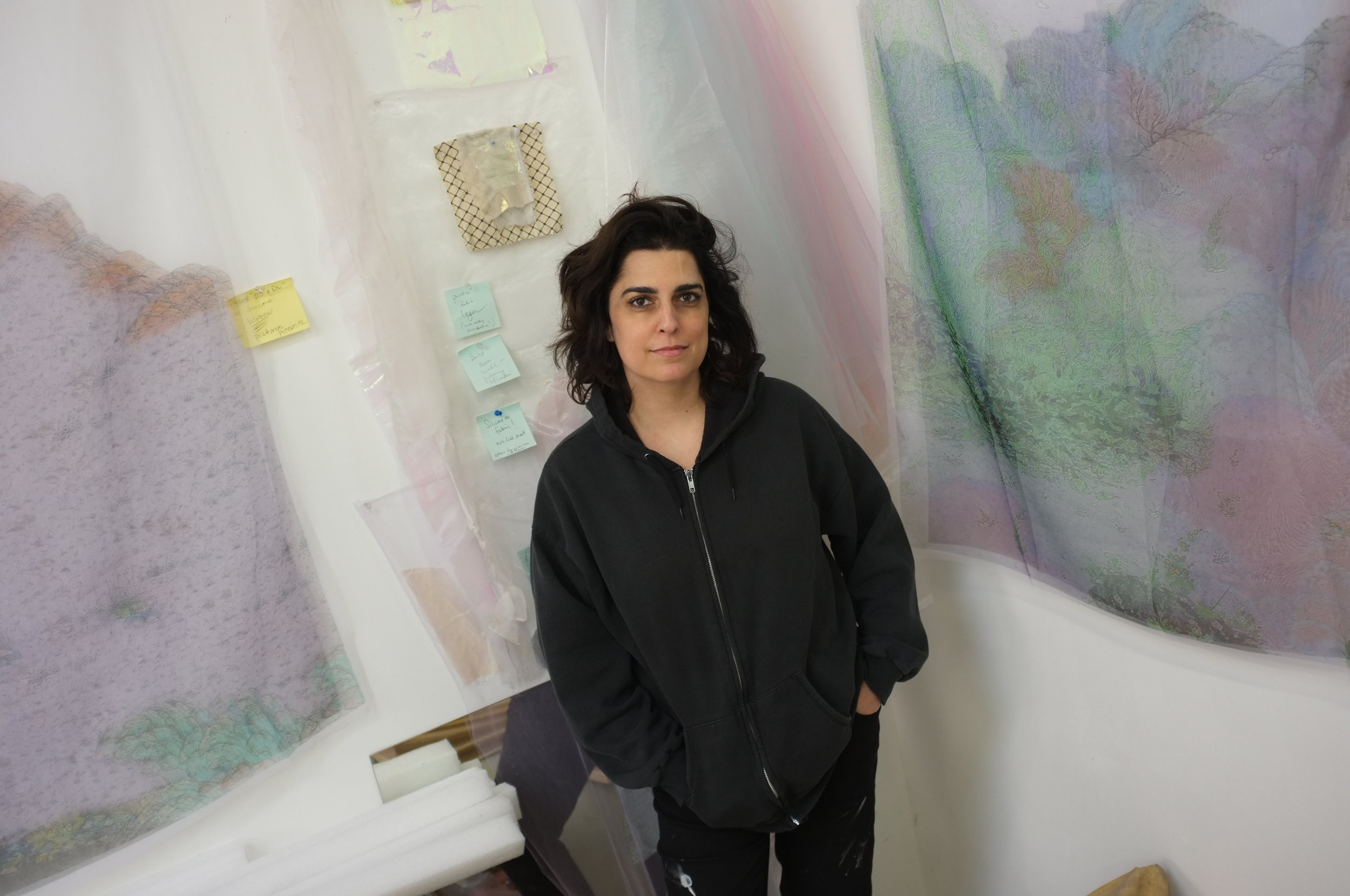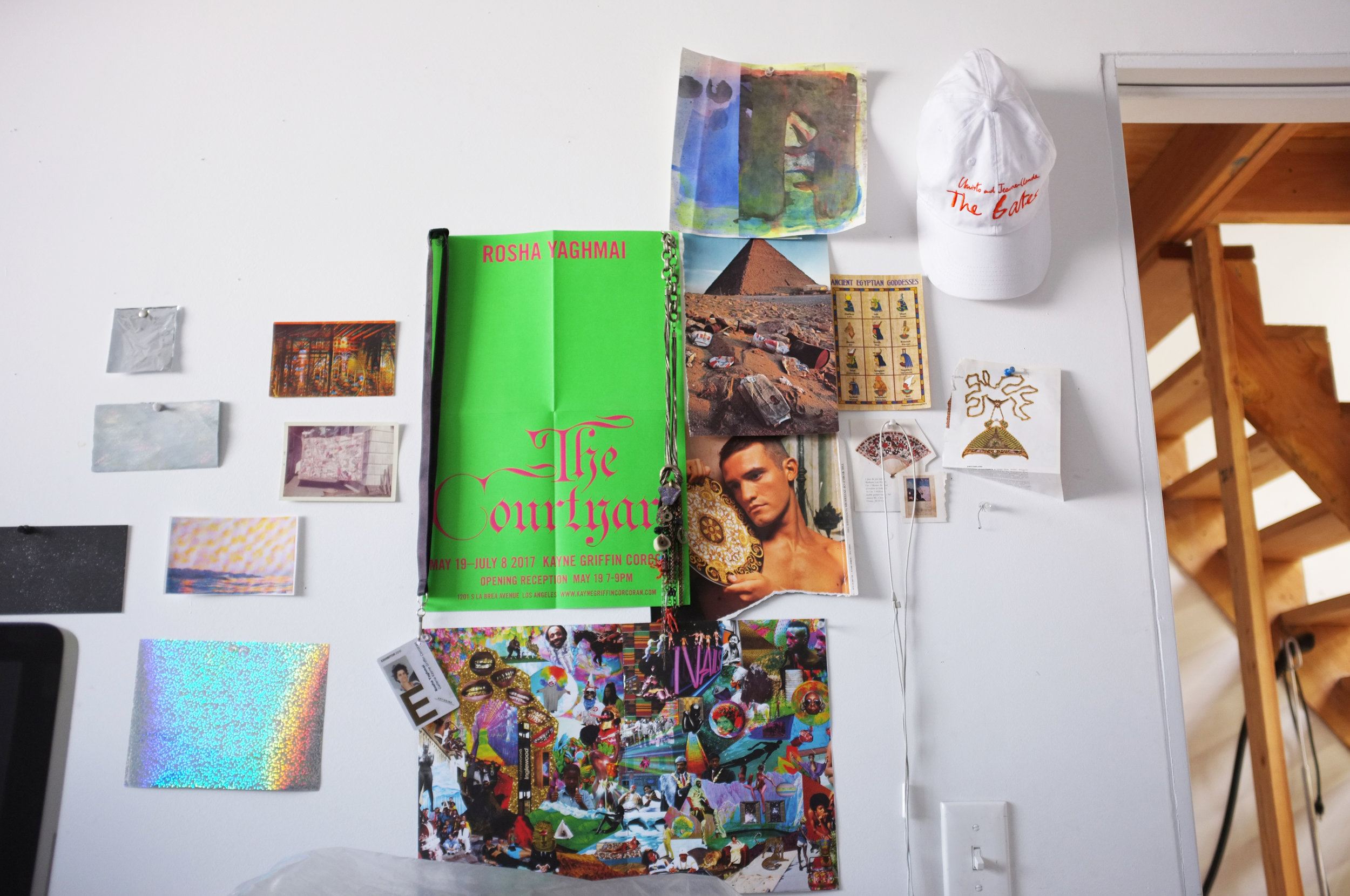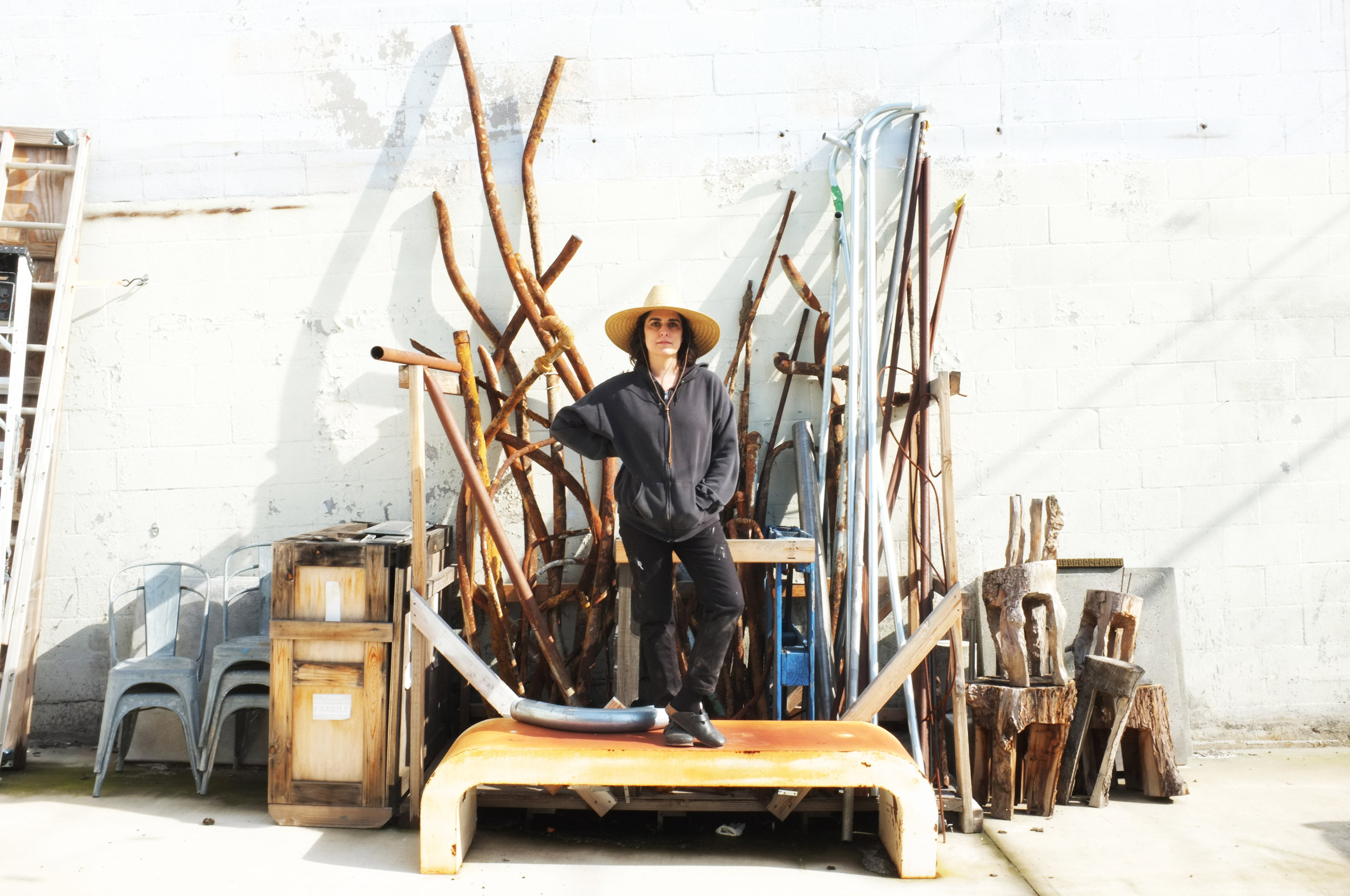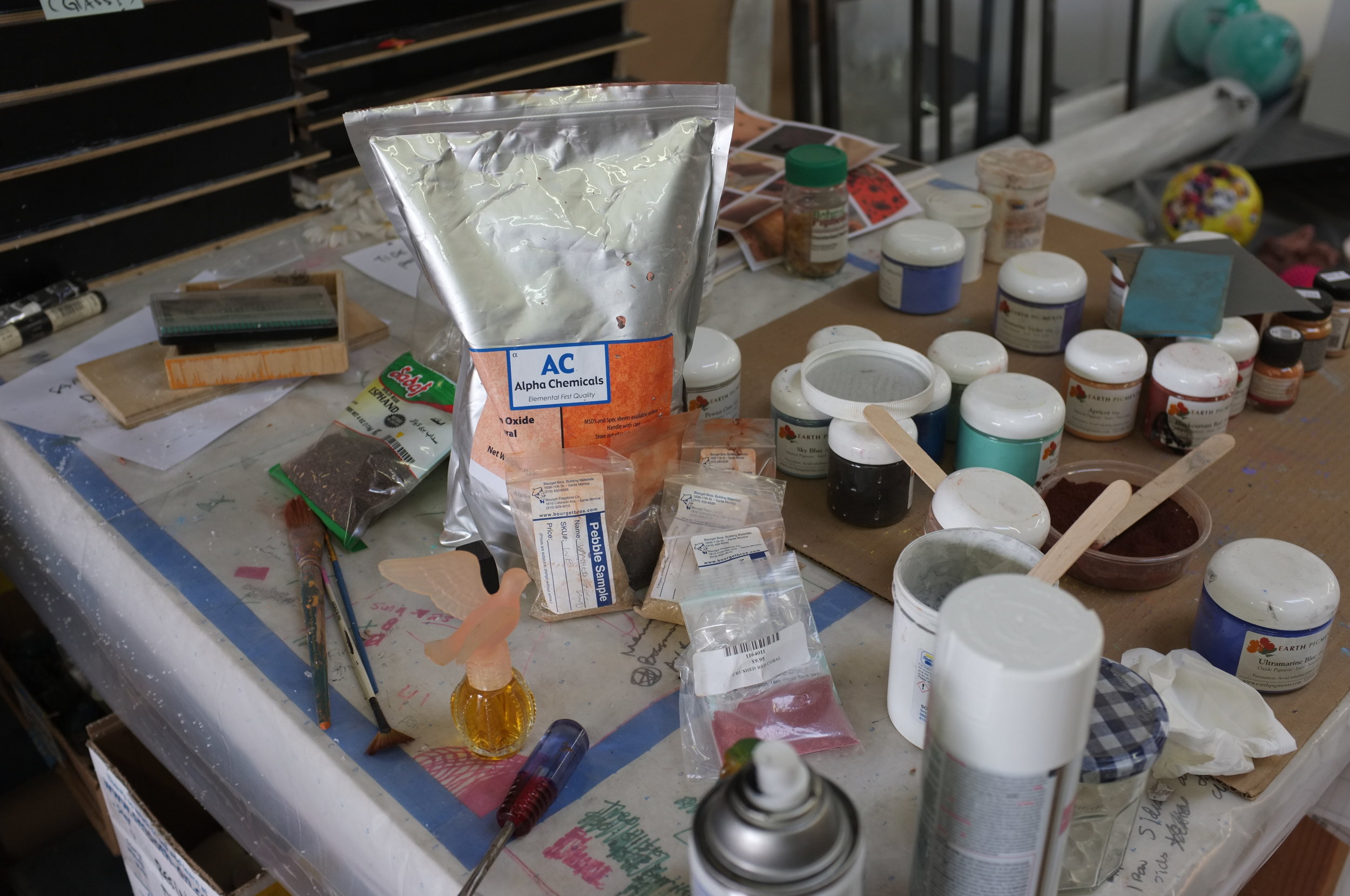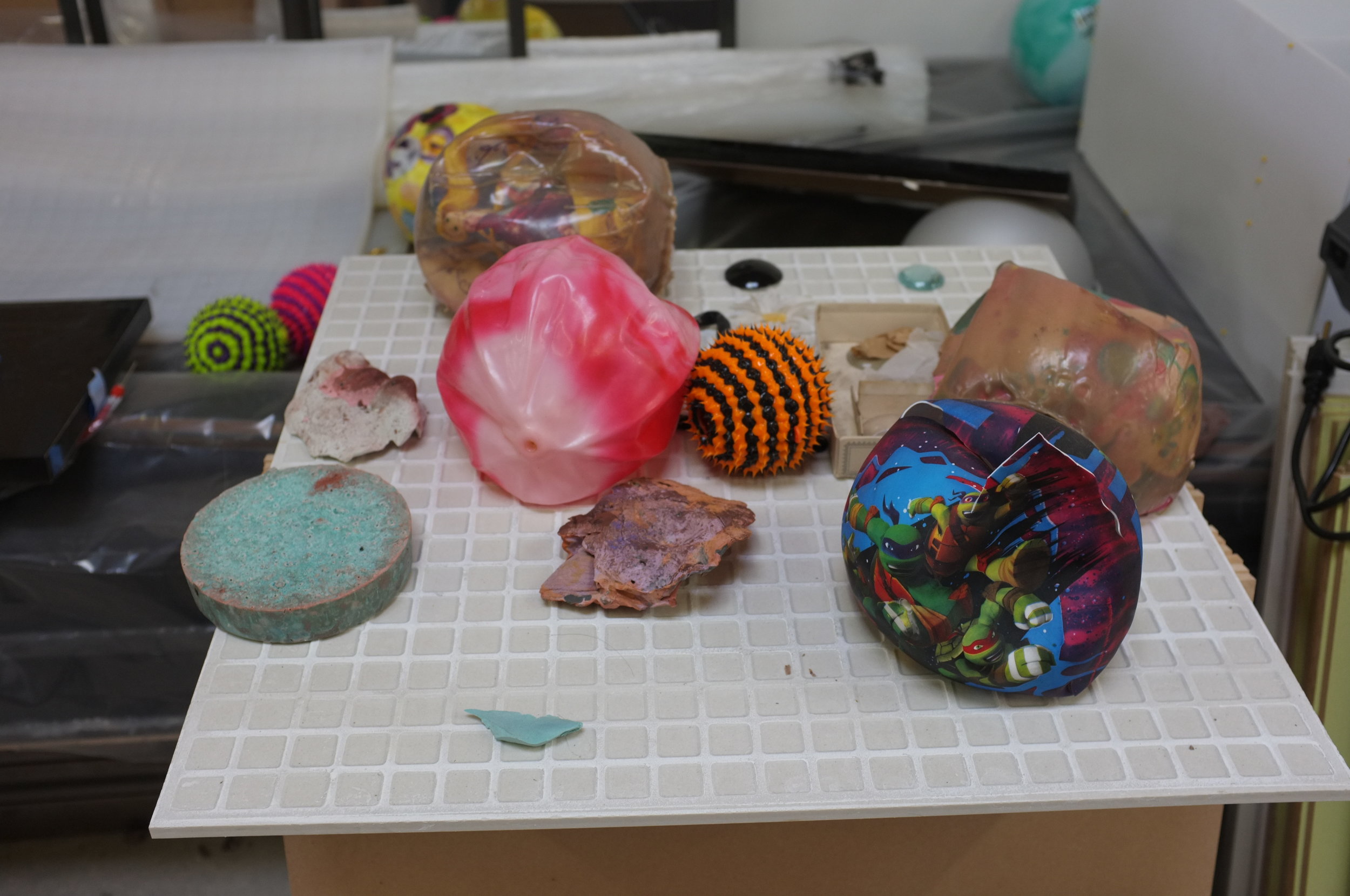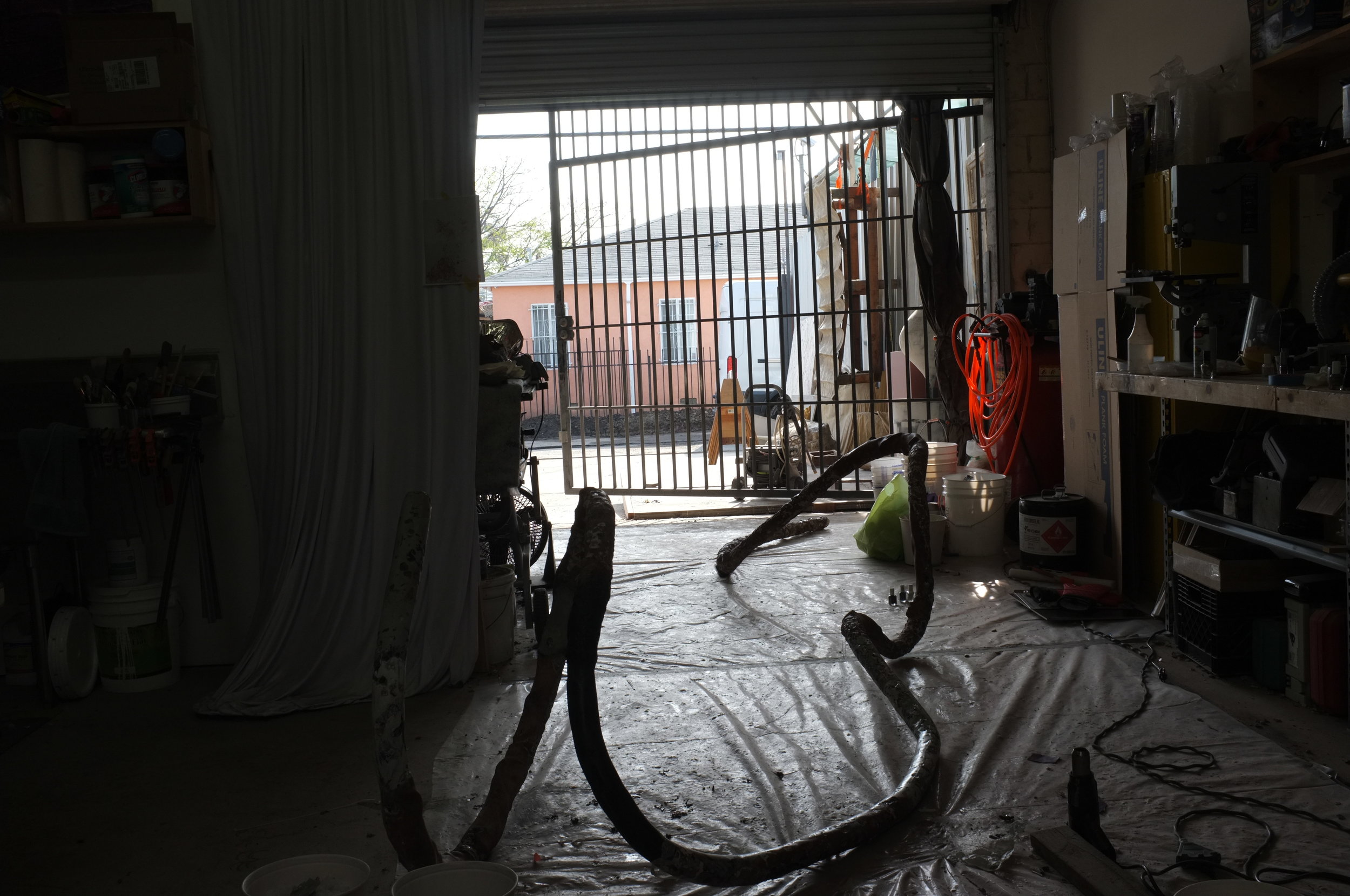interview by Summer Bowie
photographs by Oliver Kupper
Walking into Rosha Yaghmai’s studio is a little bit like walking into the laboratory of a junkyard hoarder/mad scientist. There’s a distinctly pleasant organization to the vast collection of Los Angeles detritus that extends from the studio to the backlot outside. The walls are plastered with images from torn magazine pages, postcards, posters, watercolors and collage works. It’s as though you could hold a microscope to any detail in the room and discover a tiny world within. This is especially the case when viewing the centerpiece of her upcoming exhibition Miraclegrow at the Wattis Institute in San Francisco. In the center of the room sits a giant sculpture of a human hair. Pubic? Maybe. This mysterious hair sits on a floor which acts as a pedestal of giant, reflective bathroom tiles. Encapsulating this familiar scene, the walls are covered in large black tiles, effectively wall works that appear to drip with the glistening traces of warm condensation. The hair itself is a sedimentary composite of industrial materials, cleaning products, bathroom products, nail polish, and so much more. Layers and layers of genetic material soaked in personal history. I had the chance to sit down with Yaghmai just a few days before the works made their way up to San Francisco to talk about her upbringing as a tinkering, junk-collecting Angeleno, her work and its relationship to personal heritage, and how she so compellingly defines the cosmic in the microcosmic.
SUMMER BOWIE: I want to start by just talking about your beginning. I understand that you started as a photographer and then transitioned into sculpture. What kind of photography were you making, and why did you lose interest in it?
ROSHA YAGHMAI: I started off making photographs really young. In the sixth and seventh grade. I was really interested in taking photographs. Really quickly, when I went to photo school, I spent most of my time trying to use the chemicals to do things you aren’t supposed to do. So, I never was making straight photographs. I was always altering the image, adding weird color.... I was trying to make the photographs more like paintings, but I think I was just trying to make sculpture. I would combine Xerox’s so there was this approximation of the real that I was really interested in, which seems like a natural link between photography and sculpture. I eventually started making fake diorama-like environments with the photographs, so again, pushing into sculpture. I was at SVA in New York at the time and I ended up transferring to CalArts. As soon as I got into the desert landscape, photography was gone, and I started making sculpture. I haven’t made photographs for a long time.
BOWIE: That is interesting because you often hear of artists coming to LA, discovering its unique light and then naturally pushing into photography.
YAGHMAI: I am also from here, so it was less about that, I just wanted to create environments when I moved here.
BOWIE: The work you presented at Made in L.A., Slide Samples (Lures, Myths) includes projected slides from photographs your father took when he first emigrated to California from Iran. Have you always wanted to work with these images, or did the urge come to you recently?
YAGHMAI: They’ve always been around our house. We had this one print, and I thought it was just an eighties photo, and I didn’t think much about it. My father was interested in photography and that’s how I got into photography. I had all his cameras. etc. and I saw those slides and started making slides, but nothing like that. They [the slides] have always been lingering for years. I finally just asked him about them. I knew he had made them in Berkeley. I knew he used abstract color, they were trying to be psychedelic because of the timing, 1969-72. When I asked him about it, just the process of his thinking, it was very similar to how I was making resin that I was calling slides. He was taking hunks of glass from the Coca Cola Company in Oakland and using different sources of light and filters (light from the television, etc.) to make reflective surfaces. I thought it was an interesting, strange way to connect with a new culture but also realizing there were some similar physical properties with my work: the resin, using lenses and different filters. I think up until the Hammer most of the work that I have made was some sort of screen or a way to alter a site and I linked it with that work once I knew he had made it.
BOWIE: You were born right around the time that the Shah of Iran was overthrown.
RY: He [my father] emigrated here in the mid-60’s and my parents got married and they moved to Iran... and I was actually conceived in Iran and we lived there...then the revolution broke out and we came back to the United States...and I was born.
BOWIE: Growing up in Los Angeles, what was it like being in the wake of these events as a first-generation Iranian-American?
YAGHMAI: I think my dad was so involved with being an American person that we never really talked about that stuff... I didn’t really understand until later but I feel like...I am realizing...how in much of my work there is a subconscious draw to that...or a feeling of wanting to traverse long distances, or different perspectives comes into the work. I am so disconnected from that part of my lineage, and I could ask my family, read more about it, and I do; but, I feel like I am in the process of unearthing some embedded knowledge and I think the misunderstanding and not knowing is really generative for me.
BOWIE: That makes sense. Maybe your dad was seeing America through a lens that is slowly revealing itself to you.
YAGHMAI: He only went back to Iran maybe five or six years ago, maybe because it was so awful and painful. It never really came up.
BOWIE: You said once that you take pleasure in the sort-of trashiness of LA. What aspects of that trashiness appeal to you most?
YAGHMAI: I don’t know if it just being that I am a beach-desert person, and there’s moments in that hair that are in this zone. You know, like a piece of glittering trash like in a desert landscape. Just these little moments of collage really interest me. But in terms of trashiness, I really thrive and enjoy a casual environment. I don’t know if trashiness is the right word, but I feel like (it’s not this way anymore) the feeling of complete freedom here. But now it is not quite like that. I grew up between Alta Dena and by the beach, we would just ride our bikes out, and go to the junkyard and find weird stuff, and my grandfather was a bit of a hoarder and a handyman type. We would just be tinkering. I think that is it. Thrift store shopping and finding some weird historical gem. I also have a real interest in outsider architecture.
BOWIE: I can see the psychedelic influence of your father’s work with those weird remnants of Americana that seem to litter the streets and the junkyards that used to exist. Santa Monica and Venice were very different places back then.
YAGHMAI: It was so wild there when I was growing up and trashy. It was great! The beach towns were abandoned—it was a bunch of old people and skaters. Weird remnants. It was magical, I feel lucky I grew up here during that time.
“I am realizing how much, basically, “dusk” is my color palette. That is where the light and space of California comes into my work. It is “dusk” but it is city dusk; that moment when the sky has that color and there is the neon turning on. That in-between time...”
BOWIE: You use a lot of found materials, industrial metals, liquids, resins, do you have any favorites or least favorites?
YAGHMAI: They are all a pain (sighs). I definitely do like working with materials that are liquid to solid. In terms of favorite, detrimental to my market, I just move through and use what I want. I don’t really have the usual approach. So, this show has a completely different approach than the one at the Hammer. I do like working with transparency, like this super clear, very toxic resin. My work relates to light and space because of my history and the physical properties of the work (color and all that), but I feel like for me it is much more about collaging. So, if you have one thing that’s transparent, you're altering what you see behind it, and for me that altering and blending of sight is really important. I also really like using silicone, the type of silicone you make prosthetics out of. Platinum silicon. And that has a translucent quality too but I like using that material as an approximation or stand in for the body, clear resin and that are the two things I go back to.
BOWIE: Your work has a quality about it that invites viewers to temporarily enter a foreign world and quietly meditate there for a moment. Is this an experience you look for when viewing the work of other artists?
YAGHMAI: I think you always fantasize that you make different art. I like going into a full on crazy installation...just something that looks like a playground. So, I am not always drawn to a contemplative space... I think that in my work that kind of emerges because up until very recently I was very stubborn about (sternly, “I make objects, I want to make objects”). Yet, it is teetering on installation because these objects when in relation to one another create this sort of psychological environment and their relation to each other creates an oddity you want to linger with. I feel like this show is the first time in a while that I am making an environment. I mean each object in the show... like the floor is the pedestal for the hair and the panels are paintings and they can be separated so they are still existing as objects kind of coming together for this moment but they are not props and still are works of art, or sculptures. I really think a lot about putting things together that are a bit perplexing or strange that makes one want to linger a bit and figure it out. I think that may be the color palette. I am realizing how much, basically, “dusk” is my color palette. That is where the light and space of California comes into my work. It is “dusk” but it is city dusk; that moment when the sky has that color and there is the neon turning on. That in-between time... which I think is a very contemplative time, when you are driving around that time.
BOWIE: Always in LA... I think you said that your color choices are kind of the most intuitive part of the process...
YAGHMAI: I made this whole series of silicones for this show in Germany and I realized they are all colors from my childhood wetsuits that were around. It just emerges, oh, of course, that’s why I’m doing that.
BOWIE: In this show, you said you wanted to create an environment that takes on a spider's perspective on the floor of a bathroom. What inspired this particular perspective?
YAGHMAI: I was really torn about what to do for this show. I feel like the Hammer project was sort of the end to a couple years of thinking. So I felt a bit stuck, to be honest, and I was trying to figure out what the next step was. I knew I wanted to make an environment. I was super frustrated, came home to the studio, threw down my jumpsuit, and I noticed (I hate spiders. Sorry, I’m trying to change my perspective on that) a spider trying to crawl into it, so I snatched it away. And the spider kind of stopped, and I was just watching, and thought, “what the hell does that thing think just happened?” So, I had this moment where I thought, if I am trying to make work that alters perspective in a very physical, literal embodied way, why wouldn’t the next step be to try to empathize and project myself into something of which I could never understand what their perspective would be. In terms of psychedelic properties, I think that’s the most honest way to go about it. I just wanted to physically remake it, but in a skewed way.
BOWIE: Has it changed your feelings towards spiders at all?
YAGHMAI: My husband got me this Louise Bourgeois book, and so obviously, she has those big spider sculptures, and she talks about them as a symbol of renewal. So, I’m trying to get into a Louise Bourgeois way of thinking about it, rather than just thinking about them crawling on me at night. So, I think I can empathize with them a little bit more. How scary must it be? I just wanted to make a direct approach to the show.
BOWIE: There are so many materials that went into that hair sculpture. It has this sort of sedimentary value to it...can you just talk for a moment about the different materials that you used in creating it?
YAGHMAI: I mean... it is the hardest sculpture I ever made, not in a physical way, but just that you’re really fighting the form. Not to be too literal, but your hair is a shedding of some kind of skin, and I knew I wanted to cast my body and incorporate it into the work. Almost like it is carved out of some kind of stone, or I wanted to make it seem like something that happened or something that is really forced. You don’t work on growing your hair, it just happens, but if you think about all the energies that go into making it... I used a lot of materials that I’ve used before, like limestone, graphite, household plastics like shampoo bottles, laundry soap, and shopping bags. I melted those down and put them in. It’s almost like coral where it absorbs anything that is in the environment...I was thinking about that with all the chemicals in the body and how they can all be traced in a single hair. And also, thinking back to my father and my parents, and just thinking about what you absorb in your DNA, what is trapped in there, trapped knowledge that I don’t know about. I wanted to have this sort of spacey, geological tone and I was looking at images of the sand dunes on Mars, which is basically the whole brochure for the show, which is a reach, but it’s cosmic level shit. You know, like you’re sitting here and now our molecules will be tangled forever. Things that are blowing my mind. For me it is kind of fake because it is cast and modified material, but I was trying to be really genuine and putting together a lot of stuff that I’m around on the regular.
BOWIE: There seems a deep desire to capture moments or feelings in your work; to encapsulate and oppose the forces of entropy. Would you agree with that interpretation?
YAGHMAI: I think so...there is so much in my work that is the familiar becoming foreign, and so there's this flip all the time of something so familiar (that maybe you take for granted) turning on you. I feel just that awkwardness—making you aware of your existence, of your body interacting with the object.
BOWIE: You have referred to the desire to freeze time, but is that something you feel like you want to do permanently or temporarily, and if so, for how long, what is that desire to hold things in space?
YAGHMAI: I mean, that’s sculpture. If I had one power, it would be to stop time. You know when you play that game. Just slowing down the process and pointing to that one thing and using force to stop that moment or those moments and to have it on display. Not that my work is usually that figurative, but to slow it down. Having a one-on-one relationship between the object and the viewer.
Rosha Yaghmai's exhibition Miraclegrow opens on January 15th and runs until March 30th at The Wattis Institute. 360 Kansas St, San Francisco, CA 94103

